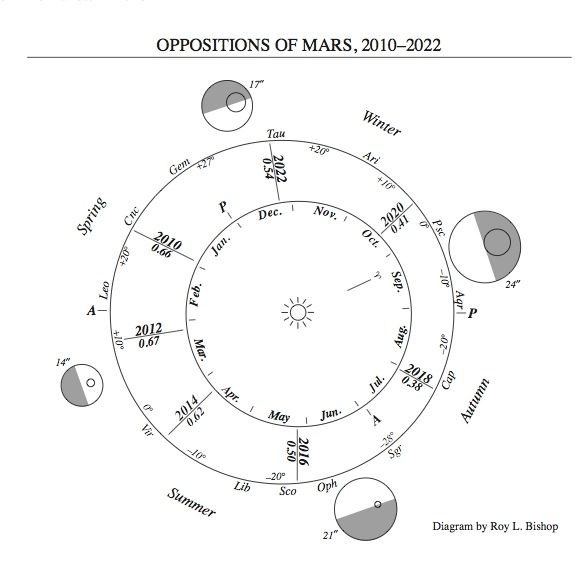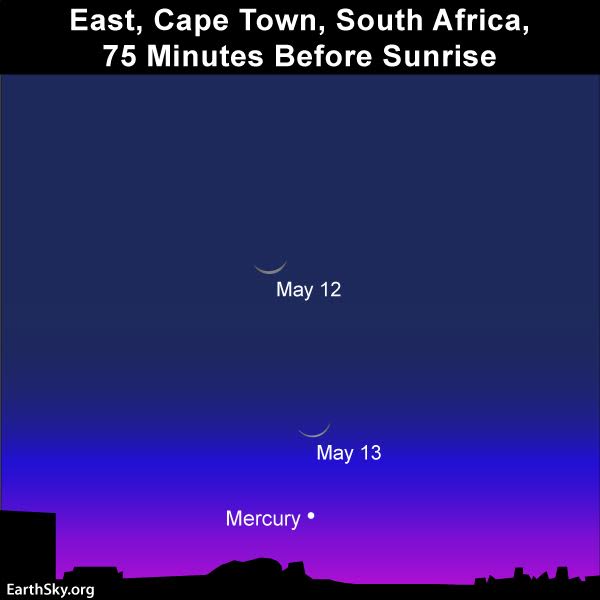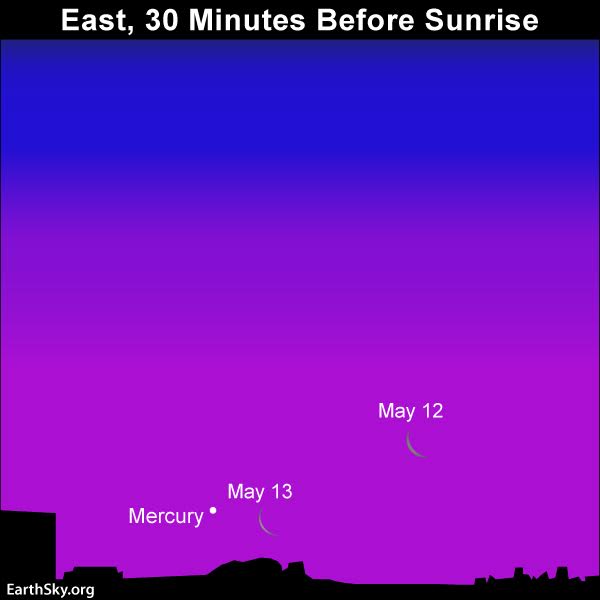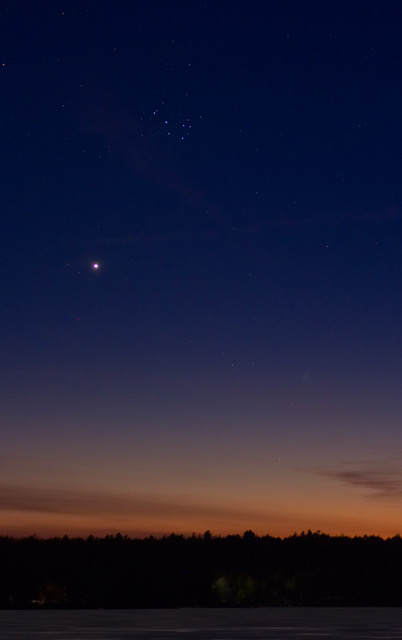
From around the world tonight – May 5, 2018 – if you’re a night owl, you might catch the moon and the red planet Mars climbing above your eastern horizon before your bedtime. From mid-northern latitudes (U.S., Canada, Europe and Russia), the twosome won’t rise until after midnight. From the Southern Hemisphere, they’ll will be up by late evening. Click here for recommended sky almanacs; they can give you the rising time of the moon and Mars in your sky.
Or … get up before daybreak to see the waning gibbous moon and Mars. They’ll be highest up for the night around dawn.
Mars is the planet to watch in 2018. By July, it’ll be brighter in our sky than it’s been since 2003. The chart below shows the cycle of oppositions for Mars, and why, every 15 or so year, we see Mars as brightest:

Mars is closest to Earth about every 2 years, when Earth passes between this planet and the sun. That event is called Mars’ opposition because, at such times, Mars appears opposite the sun in our sky. There’s also a 15-year cycle of close and far Mars oppositions, and that’s what this chart is showing. Notice that, in 2018, Mars will be especially close. The reason is that Mars’ opposition is July 27 and its perihelion – when it’s closest to the sun is relatively soon afterwards, on September 16. In 2018, Mars will be closer and brighter than it’s been since 2003. Diagram by Roy L. Bishop. Copyright Royal Astronomical Society of Canada. Used with permission. Visit the RASC estore to purchase the Observers Handbook, a necessary tool for all skywatchers.
What’s more, you’ll see two other bright planets in the predawn sky: Saturn and Jupiter.
Golden Saturn gleams close to Mars before dawn.

Mars and Saturn are in front of the constellation Sagittarius. This photo is from April 21, 2018 via Dennis Chabot at Posne Night Sky.
Cream-colored Jupiter is farther away from Mars and the moon in the May 6 morning sky, but Jupiter is unmistakably bright. In fact, in May 2018, dazzling Jupiter shines nearly all night. Watch for Jupiter in your eastern sky at nightfall. Then watch for Jupiter to climb highest up for the night around midnight and to sit low in the west at morning dawn. Earth will fly more or less between Jupiter and the sun – bringing Jupiter to its annual opposition – on May 8-9.
If you live in the Southern Hemisphere or the northern tropics, you also have a reasonably good chance of catching Mercury, the innermost planet of our solar system. Look east, near the sunrise point on the horizon as the predawn darkness is giving way to morning dawn. The moon will be in the vicinity of Mercury on May 12 and 13, as shown on the charts below. Note that the first chart is for the Southern Hemisphere. The second chart is for the Northern Hemisphere, where the view is nowhere near as good:

From southerly latitudes, the waning crescent moon helps to guide your eye to the planet Mercury on April 13 and 14. Read more.

On May 12 and 13, 2018, the moon and Mercury will be much harder to catch at northerly latitudes. Read more.
You can also see Venus, the brightest planet of all, for an hour or two in the evening sky this month. Venus shines opposite of Jupiter at evening dusk in May 2018, and sets beneath the western horizon by nightfall or early evening.

The stars of Taurus were sinking into the sunset behind Venus on April 23, 2018, when Venus was near the tiny dipper-shaped Pleiades star cluster. Photo by Alastair Borthwick at Lake Kennisis, Ontario, Canada.
Bottom line: Don’t miss the moon and Mars together in the predawn sky on May 6, 2018. Plus a word about other bright planets you can see in May.
from EarthSky https://ift.tt/2FMzPFR

From around the world tonight – May 5, 2018 – if you’re a night owl, you might catch the moon and the red planet Mars climbing above your eastern horizon before your bedtime. From mid-northern latitudes (U.S., Canada, Europe and Russia), the twosome won’t rise until after midnight. From the Southern Hemisphere, they’ll will be up by late evening. Click here for recommended sky almanacs; they can give you the rising time of the moon and Mars in your sky.
Or … get up before daybreak to see the waning gibbous moon and Mars. They’ll be highest up for the night around dawn.
Mars is the planet to watch in 2018. By July, it’ll be brighter in our sky than it’s been since 2003. The chart below shows the cycle of oppositions for Mars, and why, every 15 or so year, we see Mars as brightest:

Mars is closest to Earth about every 2 years, when Earth passes between this planet and the sun. That event is called Mars’ opposition because, at such times, Mars appears opposite the sun in our sky. There’s also a 15-year cycle of close and far Mars oppositions, and that’s what this chart is showing. Notice that, in 2018, Mars will be especially close. The reason is that Mars’ opposition is July 27 and its perihelion – when it’s closest to the sun is relatively soon afterwards, on September 16. In 2018, Mars will be closer and brighter than it’s been since 2003. Diagram by Roy L. Bishop. Copyright Royal Astronomical Society of Canada. Used with permission. Visit the RASC estore to purchase the Observers Handbook, a necessary tool for all skywatchers.
What’s more, you’ll see two other bright planets in the predawn sky: Saturn and Jupiter.
Golden Saturn gleams close to Mars before dawn.

Mars and Saturn are in front of the constellation Sagittarius. This photo is from April 21, 2018 via Dennis Chabot at Posne Night Sky.
Cream-colored Jupiter is farther away from Mars and the moon in the May 6 morning sky, but Jupiter is unmistakably bright. In fact, in May 2018, dazzling Jupiter shines nearly all night. Watch for Jupiter in your eastern sky at nightfall. Then watch for Jupiter to climb highest up for the night around midnight and to sit low in the west at morning dawn. Earth will fly more or less between Jupiter and the sun – bringing Jupiter to its annual opposition – on May 8-9.
If you live in the Southern Hemisphere or the northern tropics, you also have a reasonably good chance of catching Mercury, the innermost planet of our solar system. Look east, near the sunrise point on the horizon as the predawn darkness is giving way to morning dawn. The moon will be in the vicinity of Mercury on May 12 and 13, as shown on the charts below. Note that the first chart is for the Southern Hemisphere. The second chart is for the Northern Hemisphere, where the view is nowhere near as good:

From southerly latitudes, the waning crescent moon helps to guide your eye to the planet Mercury on April 13 and 14. Read more.

On May 12 and 13, 2018, the moon and Mercury will be much harder to catch at northerly latitudes. Read more.
You can also see Venus, the brightest planet of all, for an hour or two in the evening sky this month. Venus shines opposite of Jupiter at evening dusk in May 2018, and sets beneath the western horizon by nightfall or early evening.

The stars of Taurus were sinking into the sunset behind Venus on April 23, 2018, when Venus was near the tiny dipper-shaped Pleiades star cluster. Photo by Alastair Borthwick at Lake Kennisis, Ontario, Canada.
Bottom line: Don’t miss the moon and Mars together in the predawn sky on May 6, 2018. Plus a word about other bright planets you can see in May.
from EarthSky https://ift.tt/2FMzPFR

Aucun commentaire:
Enregistrer un commentaire